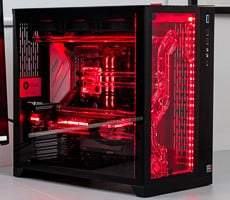Although the Maingear F131 is a premium gaming desktop at its core, we are also interested to see how it performs in work chores. So, we'll start off our benchmarks with some standard productivity and content creation metrics before jumping into the fun stuff.
 |
| Cinebench R15 |
| Content Creation Performance |
|
Based on Maxon Cinema 4D software, this test uses a 3D scene and polygon and texture manipulation to assess GPU and CPU performance. We ran the Main Processor Performance (CPU) test, which builds a still scene containing about 2,000 objects, for a total polygon count above the 300,000 mark. Here we're focusing strictly on software rendering on the CPU and it's heavily taxing on this one aspect of system performance, both with multi-threaded and single-threaded rendering.
The Maingear F131 absolutely crushed the multi-threaded Cinebench test. In the single-threaded test, it is among the fastest systems we have tested, but it can't quite catch the higher-clocked parts based on newer architectures, like the Core i7-8700K in the
Origin PC Millenium desktop. But when you overclock all of those cores in the Core i9-7960X, you can't help but push multi-threaded performance into the stratosphere.
 |
Futuremark PCMark 8
|
Simulated Application Performance
|
|
PCMark 8 simulates the workloads computers face in several different settings, including home, office and content creation. The benchmark also has a test that simulates
a creative professional’s usage, as well as battery and storage tests. We ran the tests with OpenCL acceleration enabled to leverage the power of the system's GPU, CPU and storage subsystem combined.
PCMark 8 has the Maingear F131 finishing about in the middle of the pack. This benchmark is influenced by a number of factors in the system, including the CPU, GPU, memory, and storage subsystem, and not every test is multi-threaded. When you factor in the higher IPC performance of some other architectures with equally fast storage and memory, this is how things play out. Still, the F131 is extremely capable for the type of workloads presented by PCMark and the lighter-duty requirements of the productivity and communications tasks that are represented in it.








